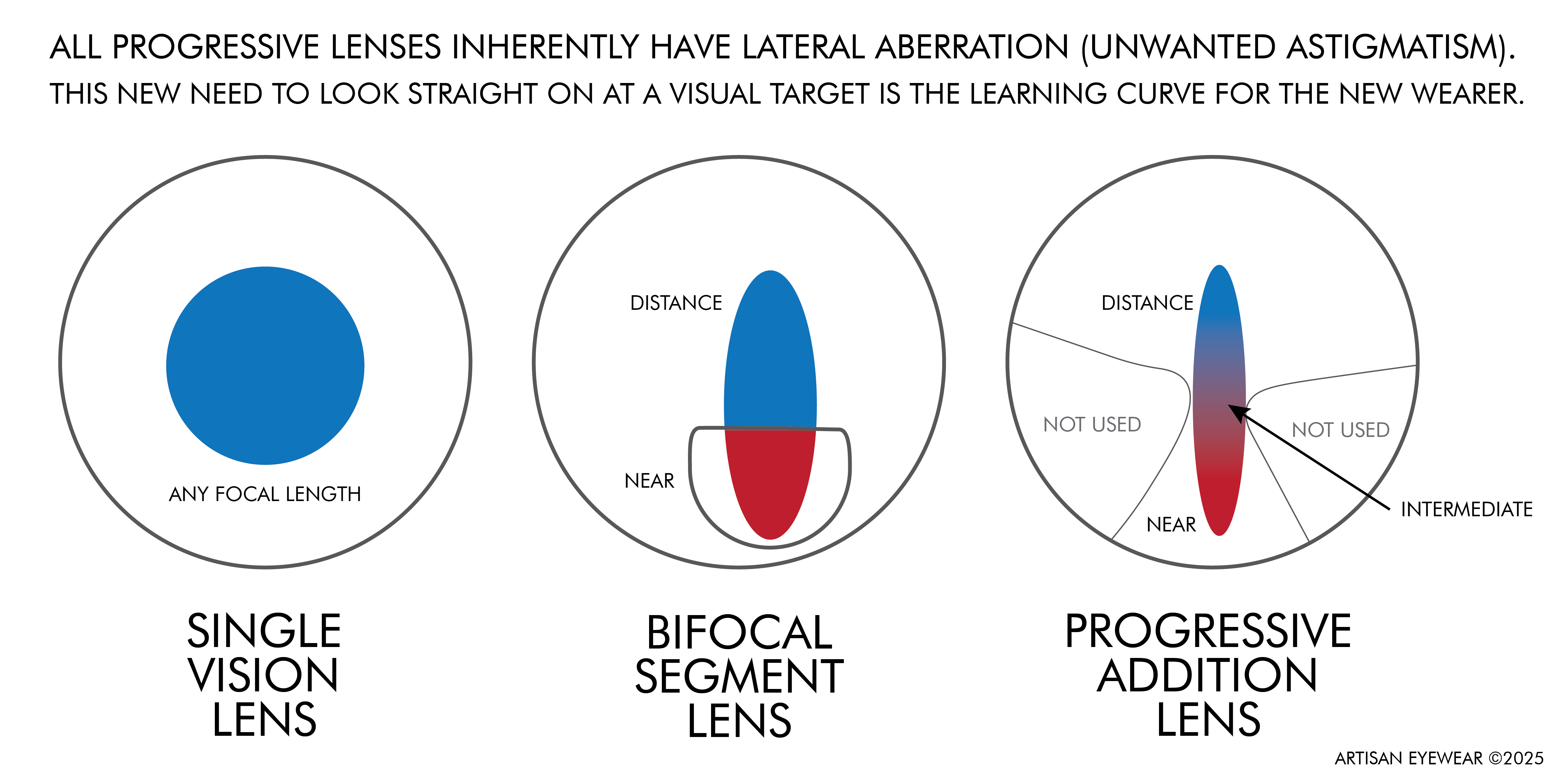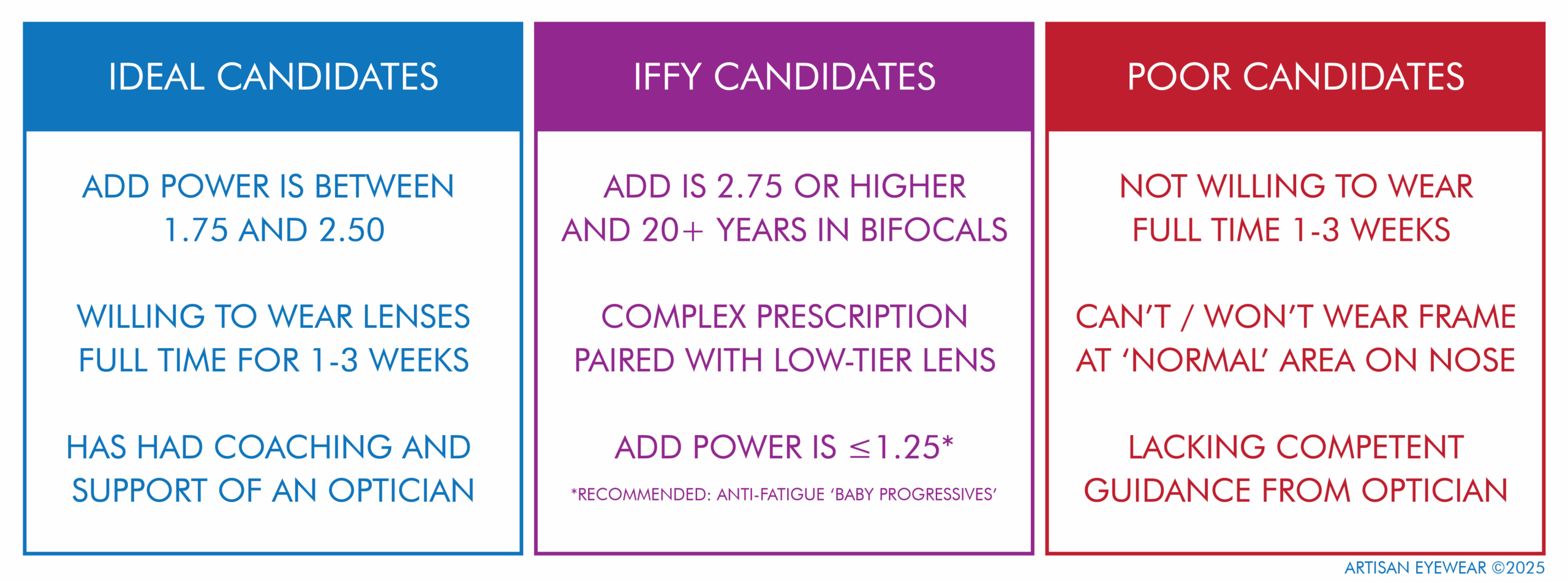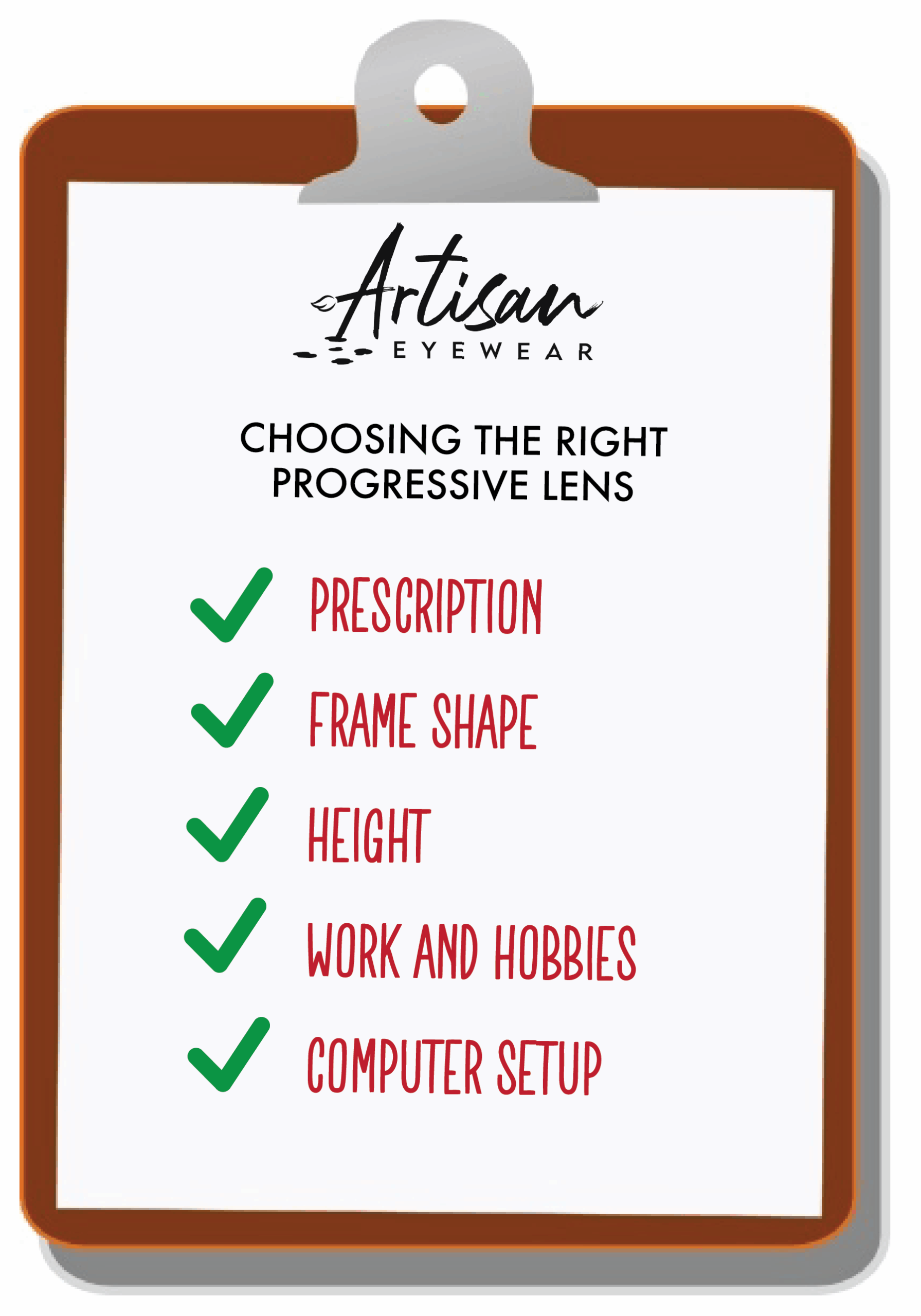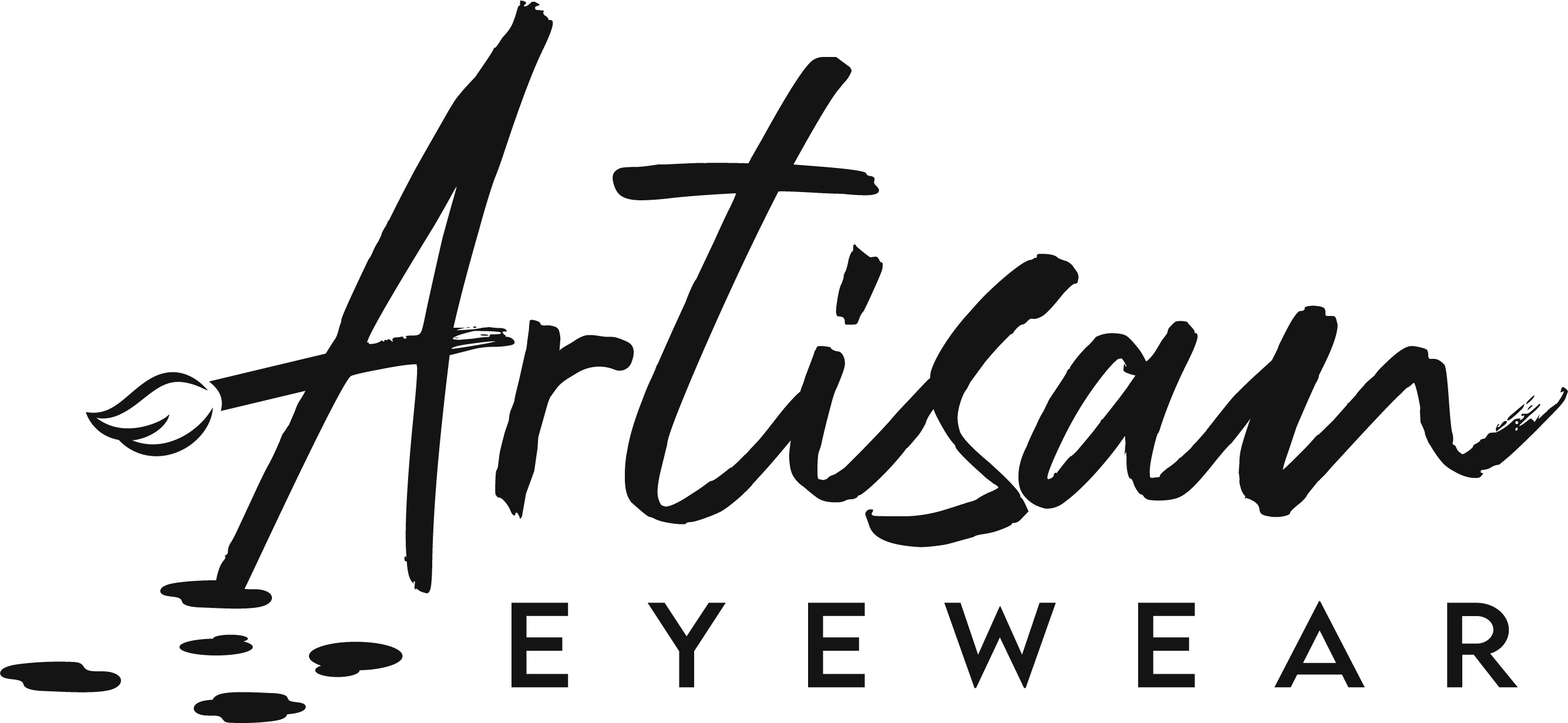Progressive Lenses Explained: A Complete Beginner’s Guide
by Natalie Taylor, LDO
I’ve been an optician for over ten years, which means I’ve spent hundreds of hours explaining, fitting, and troubleshooting progressive lenses. First-time progressive lens wearers don’t typically get the chance to talk to a trained professional for the length of time it takes to adequately cover everything touched upon in this article.
I’ve separated this content into two parts: the first covers the questions folks want to ask before they purchase their first pair of progressive lenses. In part two, I will provide tips for your first few weeks in your new lenses, as well as troubleshooting if using them is proving difficult.
My comments on who should [and shouldn’t] wear progressive lenses are based on my professional experience and opinions, and shouldn’t be interpreted as hard-and-fast rules held by all eye care professionals.
If you live in Vermont or New Hampshire, I hope you’ll come visit my boutique in Norwich, Vermont so we can work together!

Progressive Lenses vs. Regular Glasses: What’s the Difference?
This question is a common Google search, so I’ll cover the 3 general ophthalmic lens categories.
A ‘normal’ or single-vision lens has one power throughout the entire area of the lens. Most children and adults under 45 (give or take 10 years!) wear a single-vision lens to correct either nearsightedness or farsightedness.*
There are bifocals, which consists of a single-vision lens that corrects for a person’s far-away sight as well as a small segment of lens implanted on top to correct for close-up sight. This is often termed a ‘flat top bifocal’ as the top of the segment is flat; most commonly the segment is 28mm wide at its widest point. The segment is quite visible, affecting the look of the lenses.
Progressive lenses are sometimes referred to as a ‘no-line bifocal,’ but they are much more sophisticated than that. Progressive lenses provide far-away, intermediate, and close-up vision in a smooth progression; the zones are blended so there isn’t the jarring visual jump that comes with a lined bifocal. There are over 200 progressive designs on the market today, and in an upcoming segment I will review how these designs differ.
The (Brief) History of Progressive Lenses: From Bifocals to High-Tech
Progressive lenses are still the new kid on the block, and I want to quickly describe where we started.
Single-vision glass lenses have been described in some of the worlds’ earliest written records, while the development of eyeglasses took place in the mid to late 1200’s. [If you ever get the chance to peruse Moss Lipow’s book “Eyewear: A Visual History: 1941-Present” it contains images of frames going back nearly 500 years!]
At around age 45 the human eye ages to the point of needing some help seeing up close. This is referred to as presbyopia. Benjamin Franklin is credited with developing bifocal lenses as an alternative to multiple pairs of single vision glasses. The additional technology to correct for astigmatism was developed in 1825.
Progressive lenses took a long time to develop, with attempts documented in 1909 and an early patent granted in 1923. The first commercially successful progressive lens launched in 1959. There have been huge advances since then; freeform technology was introduced in the year 2000 and adjustable progression lengths were introduced in 2006. Today’s lens companies actively compete with one another to improve on the progressive lens, rapidly spawning newer and better technology.
Why Progressive Lenses Might be Right for You
Presbyopia results in a steadily increasing ADD (reading) power, so it’s prudent to learn to use progressive lenses sooner than later. Having a single pair of glasses that “do-it-all” means you aren’t putting glasses on and off all day: less wear and tear on your frame, less chance of smudging lenses or misplacing your glasses, and it’s one less thing for you to think about and juggle.
Adapting to progressives for the first time after age 70 or 75 when your ADD is +2.75 or +3.00 can be significantly more challenging; In this case I often recommend sticking with a bifocal, trifocal, or separate pairs of single-vision glasses.
Who Should [and Shouldn’t] Wear Progressive Lenses?
If your doctor prescribes progressive lenses, it’s because you need a boost of power at near; in theory, you should be able to comfortably keep your glasses on morning to night. When I interview clients about their visual needs, if I get the impression he or she desires to wear the glasses as little as possible, I steer that person away from progressives. It’s very difficult for your brain to learn how to use these lenses if you’re only wearing them for an hour here and there, and (unsurprisingly) the wearer is left feeling frustrated. Unless you allow your visual system plenty of time to get used to the progressive lenses initially, the adaptation process will be longer than it needs to be.
Some unique and unusual prescriptions, particularly when a prescription is very different between the left and right eye, will also give me pause as an optician when fitting progressives.
A common question is whether a client can switch back and forth between different lens designs: a reading pair, a progressive pair and prescription sunglasses, for example. Definitely! The only factor that could make that difficult is if you’re blending new and old prescriptions, and then my answer would be case by case.
Bottom Line: Your optometrist and your optician should both be used as resources in predicting your success with progressive lenses, so come to your appointment(s) prepared to communicate your visual needs.

Choosing a Progressive Lens: What Opticians Consider
Seasoned opticians know the important part of their job isn’t frame selection — it’s LENS selection. I love sharing information about my field, but it’s very important to preface this section by stating that your optician is responsible for analyzing all variables and suggesting a progressive design that will work best for you. Also, a lot of lens technology is gate-kept in our profession, which means DIY research won’t be a fruitful endeavor. If lens design is important to you, your best bet is to partner with an experienced and educated optician.
Okay, let’s get into it. What are those variables that go into lens selection? I like to take into account the following:
- Your prescription (the most complex consideration, by far; there are dozens of sub-variables)
- Visual demands of your job
- Visual demands of your hobbies and other activities
- Your height
- Experiences in other lenses, which we discuss at your visit
- The shape of the frame you want – is the front flat vs curved, for example
- For computer users, the position of your screen(s)
- The difference between your monocular near vs distance pupillary distances
- The distance between the bottom of the frame’s lens and the center of your pupil
Now that you know all that, consider this: depending on where you purchase your new progressive lenses, your 200+ designs options may be reduced to one or two designs. This is true of online retailers like Zenni and eyebuydirect. Ordering via a vision discount plan like VSP, DavisVision, Spectera or EyeMed will also reduce how many designs are available. Only an independent optical shop like Artisan Eyewear has unfettered access to all lenses to provide exactly what you need, no compromises.

What are the aspects of a progressive lens that make them good, better, best?
When consumers think of good, better, best, we might be equally evaluating quality and price. My goals with this passage are to explain why progressive lenses are more expensive than bifocal lenses, as well as why progressive lenses are priced in tiers that can vary by hundreds of dollars.
One quick note: the material a lens is made with (i.e. plastic, polycarbonate, 1.67 high index, etc.) is a separate and distinct variable from the design of a progressive lens. All progressive lenses are availabe in at least two different materials, but they aren’t all available in every material out there. The material used can change the price of lenses by $100 or more.
A progressive design is carved into a lens blank by a computer-controlled machine called a generator. Examples of progressive lens brands are: Essilor, Shamir, IOT, Seiko, Kodak, Nikon, Hoya and Zeiss. These companies conduct a hefty amount of research and development, release new designs and retire old ones every few years. In addition to the money put into research and development, there is software licensing involved in every lens made. The equipment optical labs use for progressive lenses is also a significant expense, with some machines priced at half a million dollars!
If you’re interested, this YouTube video does a great job showcasing all the steps involved in making any kind of ophthalmic lens.
Progressive lenses are complex to make, and the more intricate or customizable lenses cost more. Here’s an overview:
If you remember from the History lesson earlier, freeform lenses have been around since 2000 and are considered higher quality. These are not available in ‘ready-in-an-hour’ optical shops, as they are highly specialized to the wearer. They also cost more than the ‘older’ designs. Freeform or ‘digital’ lenses are digitally surfaced on either the front or both sides of the lens depending on design, which means a flatter-profile lens than average in addition to better optics. The machine is guided by sophisticated computer programs to move in three dimensions, taking into account the X, Y and Z planes.
Beyond the method of applying designs, the computer systems used provide a more high-tech lens. For example, some progressives use “Digital Ray-Path®” which uses a three-dimensional calculation model that takes into account the actual position of the lens and the natural movements of the human eye (along with additional measurements taken by your optician) to better personalize your progressives and achieve better vision in all zones.
Some manufacturers have advanced freeform options which are fully customizable with faster adaptation and minimal distortion.
After interviewing my clients for visual demands and interpreting their prescription, I usually end up with one or two lenses in mind. I don’t recommend high-end lenses for people with simple prescriptions, healthy eyes and average visual needs because they won’t be able to appreciate the difference in quality the way clients with a strong or complex prescription would.
How To Prepare for Your Progressive Lens Appointment
As your optician, I have questions. In the weeks leading up to your visit to purchase progressive lenses, consider the following:
-
-
-
- How often do you drive? Do you feel safe driving at night?
- How many hours a day are you using a computer? How far is your face from the screen? How high off the table is the monitor/screen?
- During which tasks or activities do you struggle visually?
- What other tasks do you do for extended periods of time? Your optician might ask you relevant details regarding working distances
- Do you experience headaches, dizziness, or other symptoms after extended high-focus tasks?
-
-
It’s also smart to bring your glasses – ‘bad’ glasses are arguably more informative to me, so if you weren’t happy with your last pair don’t leave them at home.
Next Time…
Thus concludes Part One of everything I think a new Progressive Lens Wearer ‘ought to know.’ In Part Two I’ll be writing for readers who have recently been fitted with new progressive lenses and things are not 100% perfect. I’ll walk you through things you can test out and analyze before bringing your glasses back to your optician for troubleshooting, so you can better understand what’s happening and why.
In addition, I’ll describe what a “normal” experience feels like, tips on how to speed up the learning process, and how to know when to replace or reevaluate your progressives. Thanks! ~Natalie
*For those with prescribed prism: prism can be added to any kind of lens, but if your doctor has measured different prism strengths at distance and near, progressive lenses are usually not an option.
